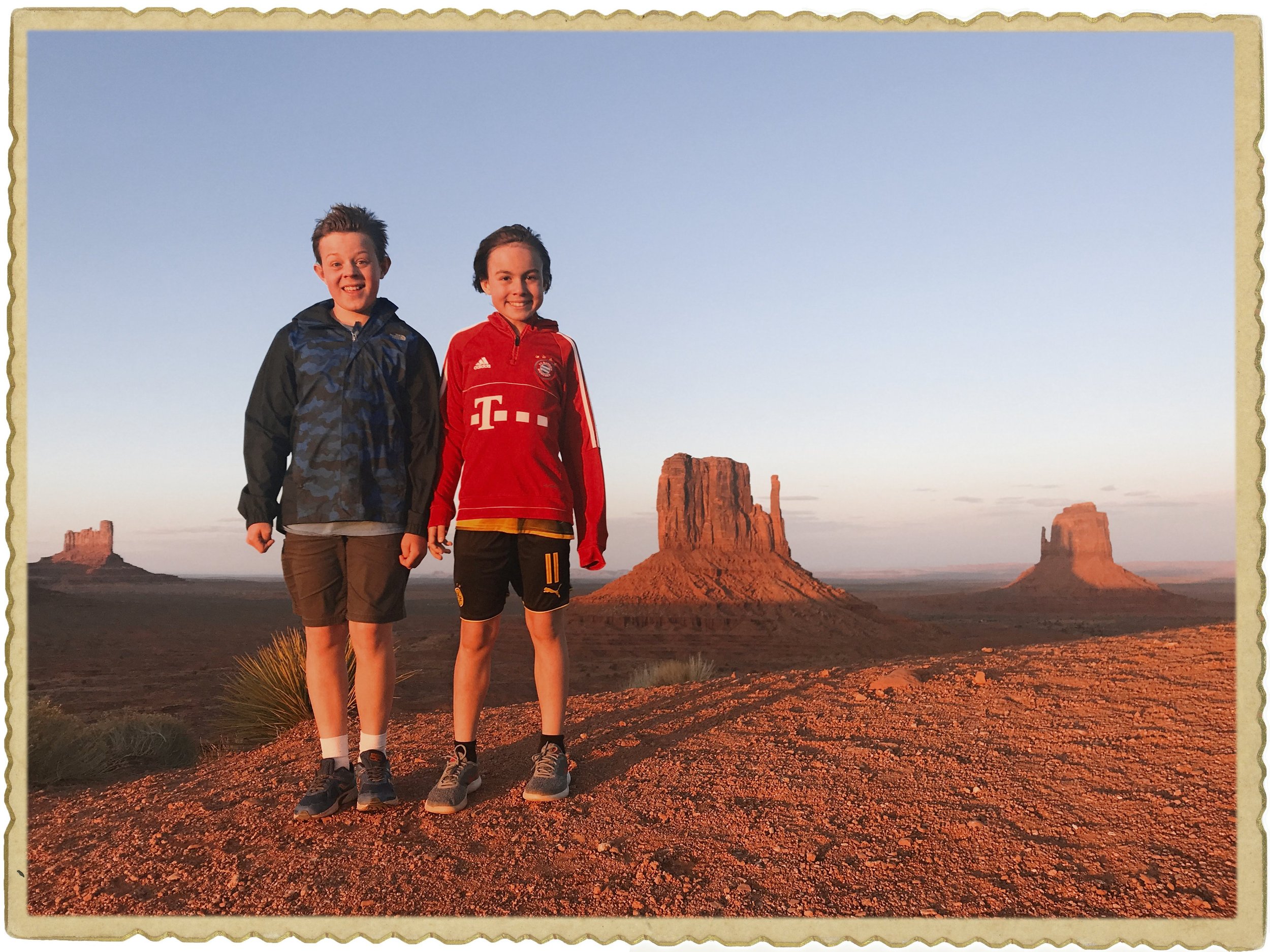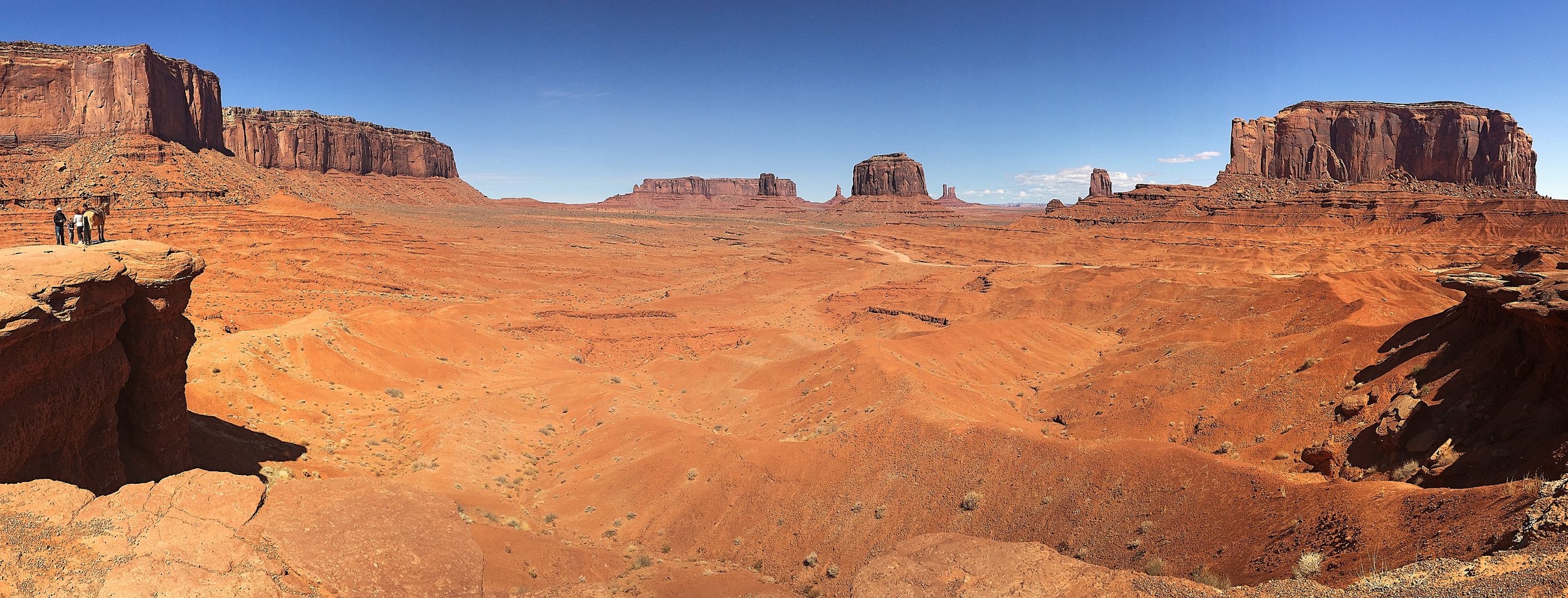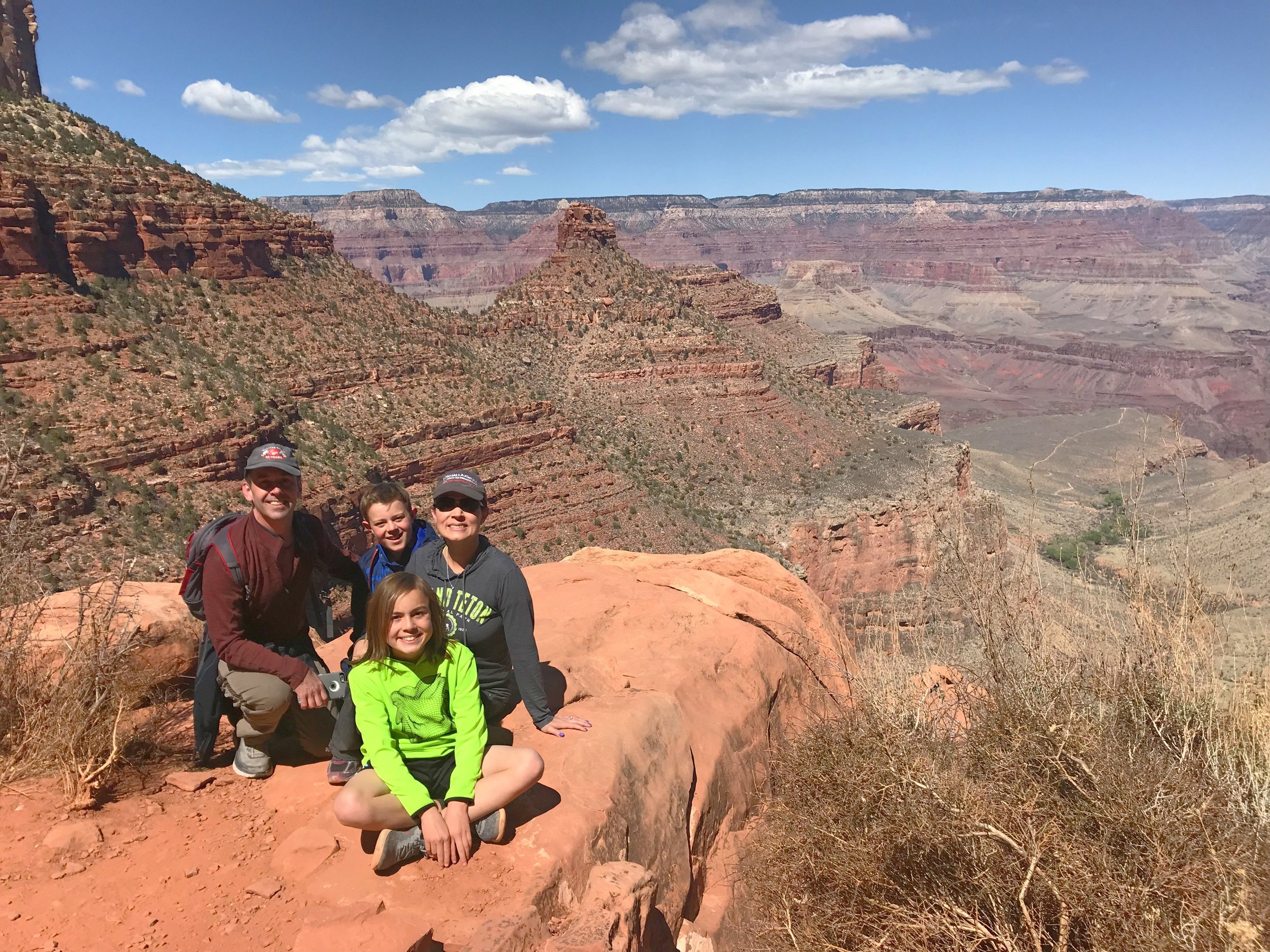A family road trip through America’s Southwest
Experiencing some of the most magical landscapes in the U.S.
Photos by Michael Mundt
The boys during a very windy sunset in Monument Valley.
Famous 20th-century American writer Edward Abbey may have been a controversial environmental figure throughout his career. But his mastery in describing America’s Southwest is irrefutable.
“Standing there, gaping at this monstrous and inhumane spectacle of rock and cloud and sky and space, I feel a ridiculous greed and possessiveness come over me,” he writes of Utah’s Arches National Park in his autobiographical book Desert Solitaire (1968). “I want to know it all, possess it all, embrace the entire scene intimately, deeply, totally.”
His description so aptly describes the world’s fascination with this landscape and the reason we wanted to share the wonder of American’s Southwest with our boys. From our home near Denver toward Arizona’s Monument Valley and Grand Canyon National Park, to Moab, Utah, the gateway to Arches and Canyonlands National Parks, we aimed in one week to “embrace the entire scene.”
Here are the highlights from our March 2018 Spring Break road trip.
1. Four Corners Monument
This Navajo Nation monument is more than just the point where four states meet in one spot —Arizona, Utah, Colorado and New Mexico—distinguished as the only quadripoint of its kind in the United States; it’s also a rite of passage for Colorado natives to visit.
Located some 420 miles from Denver (about a 7.5-hour drive) located off U.S. Highway 160, this was the perfect side trip en route to the day’s end point, Monument Valley (about two hours west). To be sure, there’s not much out there, save for the long line you’ll wait in to take a photo at the actual bronze disk marking the “four corners;” a craft market by local Navajo and Ute artisans and a fry-bread stand, the kids’ and my first taste, but it was still worth a stop.
Yes, yes, I know: The exact spot is said to be roughly 1,800 feet off course, due to some disagreement about where the borders lie and rudimentary surveying technology in 1912, when the monument was established. (You can read a recent article about it here. But as far as I’m concerned, I had my body in four states at one time, relatively. In other words, mission accomplished.
Since there doesn’t seem to be an official site, check out Visit Arizona for more information.
2. Monument Valley
The vast, iconic landscape of Monument Valley.
Few landscapes illustrate the beauty of the American West like Monument Valley, a sight so stunning it’s obvious why the Navajo Nation consider it sacred land. A region of the Colorado Plateau characterized by iconic, sandstone buttes spanning the Arizona-Utah border, this area known in the Navajo language as “valley of the rocks” lies within the tribe’s Reservation.
A frequent backdrop for several Westerns—including John Ford’s “Stagecoach” (1939) and “The Searchers” (1956), both starring legendary actor John Wayne—my family knew immediately it also inspired parts of Radiator Springs in the first “Cars” (2006), specifically Ornament Valley.
And, if you’re asking me, the only place to stay is at The View Hotel, the first and only hotel located inside the Tribal Park (located adjacent to the Park Visitors Center), which opened in 2008. Owned by the Navajo Nation and built to blend with the environment, all 95 rooms offer a private, east-facing valley with panoramic views of the Valley and its most iconic geologic landmarks: West and East Mitten Buttes. We opted for one of the private cabins, which feature a private porch, as well as kitchenette and bathroom, and can sleep up to six guests. The property also features campsites and a dining room.
I wish we’d had more time to spend hiking and exploring the area—Utah.com offers trail ideas here—but we only had time for the 17-mile Valley Drive loop. Taking us past John Ford’s Point, where we stopped for photo opportunities like the kitschy Navajo on a Horse (actually, Colin on a Horse), the drive offers up-close glimpses of the area’s numerous rocky masterpieces.
Click here to read about some popular hikes. If you have more time, here’s a Trip Advisor link to some of the best Monument Valley tours.
3. Grand Canyon National Park
I have waited 44 years to visit this iconic American Southwest destination, one of the country’s oldest national parks (founded in 1919). A 1-mile-deep gorge carved ad infinitum by the legendary Colorado River, the Grand Canyon National Park (GCNP) is considered among the world’s seven natural wonders; obviously, I was not disappointed.
Indeed, I was as awed by the Park as I had expected, amazed by its vastness, its color, and, as an Israeli woman described to me, its “bigness.” But what shocked me the most was the crowds during spring break, which are equal to summertime highs. As is the trend with U.S. national parks in general, the number of visitors to GCNP is on the rise: GrandCanyon.com says more than 4.5 million travelers visited the park in 2013; more than 6 million visited in 2017.
Open year-round, the South Rim is the Park’s most visited spot, complete with the Grand Canyon Historic Village, the largest example of Park Service town planning in the National Park system. Set along the actual rim of the Grand Canyon, more than half the buildings were designed by American designer and architect Mary Colter—including Bright Angel Lodge, Hopi House, Hermit’s Rest, the Desert View Watchtower, and the renowned Phantom Ranch, the only lodging below the canyon rim—and are considered National Historic Landmarks (built in the early part of the 20th century).
And while there are plenty of hotels in the general area, I can’t imagine staying anywhere else but inside village, both due to the drive into the park and crowds. During our two-night stay, we opted for one night at the Kachina Lodge (the only availability at the time) and another at Mather Campground.
Next time we visit the South Rim, I’m making reservations long in advance for the South Rim’s crown jewel, El Tovar Hotel. A 78-room lodge that opened in 1905 with financing from the Santa Fe Railroad, at the time it was considered one of the fanciest hotels west of the Mississippi. In addition, I’m obsessed with the idea of staying at Phantom Ranch, which requires entering into a lottery system a year in advance.
There are several dining options in the village as well, including the El Tovar Dining Room—which is popular and requires dinner reservations, although we just showed up for breakfast—a coffee house, a pub (with pizza) and even a general store.
With that in mind, my recommendation for a hassle-free, two-night stay in GCNP is to book village lodging, hike on one of the trails you can take right from the area—the very popular Bright Angel Trail, which we took 3 miles down into the Canyon (6 miles roundtrip), or the paved South Rim Trail—then refuel at one of the many available restaurants. And be sure to take one of the tours, whether braving a mule ride or taking a sunset tour via bus, as we did our first evening. Make it easy on yourself and family to enjoy this majestic natural wonder!
4. Moab, Utah
A town that’s practically synonymous with the phrase “outdoor enthusiast,” Moab is home to some of the best mountain-biking trails in the world (Slickrock, anyone?) and is the gateway to two of Utah’s five national parks, Arches and Canyonlands (5 and 32 miles from park entrances, respectively). There is so much outdoor activity here, in fact, that the two days we spent weren’t even close to sufficient.
But we crammed a ton of activity into the 48 hours we spent here, starting with a Windgate Adventures half-day “Funnel Arch Rappel.” My boys love climbing, but I do not. However, with great patience and guidance from owner Eric Odenthal, I was able to scramble/climb the path required to get to our final destination, Funnel Arch (without hurting myself or being teased by my boys because I’m afraid of heights!).
“Look around,” said guide and owner Eric Odenthal, pointing to a row of jeeps below our viewpoint, a panorama of monochromatic red rock topped with endless blue sky. “There’s all these people around, but it’s like we have the place to ourselves.”
That evening, we opted for a Hummer Safari Tour via Moab Adventure Center, the one-stop-shop for just about any adventure in the area. From rafting to mountain biking and hot-air-balloon rides, the three-hour Hummer tour was the ideal option for maximizing our sight-seeing capabilities in a short amount of time. Journeying along Hell’s Revenge 4x4 Trail (which crosses Slickrock), the pinnacle was neither the sunset nor the accompanying snacks but rather the halfway point, a stunning, Colorado River overlook.
For lodging, there’s a ton of nice hotels along the town’s Main Street, but one of the most unique was Under Canvas, a “glampsite” located 7 miles north of town. Featuring canvas tents and teepees—ranging from basic tents complete with king-size beds and wood stoves to ones with private en-suite bathrooms—Under Canvas was a great compromise between my kids’ love for camping and my mild distaste for it. (Our tent included use of community bathrooms, six private ones with toilet, sink and shower.) Notable meals? A stop at the tasty Quesadilla Mobilla food truck and dinner one night at The Spoke on Center.
Finally, both of the national parks are worthy of weeklong visits each, but keep in mind neither offers on-site lodging. With limited services, that means either driving in for a day trip—in Arches, we drove and explored highlights like The Windows and Delicate Arch, at Canyonlands, we drove to the Grand View Point Overlook—or camping in the park. Another option? Exploring the latter via bike with one of my favorite family-friendly companies, Moab’s own Western Spirit Cycling, specifically the 5-day trip through The Maze.





